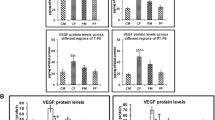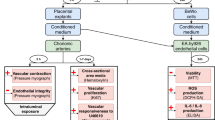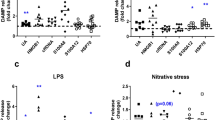Abstract
Intrauterine inflammation is the main reason for neonatal adverse outcomes and normal placenta perfusion plays an important role in fetal development. However, whether inflammation will affect placental angiogenesis and the underlying mechanism are still poorly understood. To investigate lipopolysaccharide (LPS)-induced intrauterine inflammation on placenta angiogenesis and Wnt5a-Flt1 expression. LPS-induced intrauterine inflammation rat model was established. Preterm rat outcomes were analyzed and angiogenesis of placenta villi was calculated by immunohistochemistry (IHC) of CD34 staining, and placenta Wnt5a-Flt1 expression was detected by western blot and IHC. Compared to control group, neonatal rats in LPS group showed higher death rate (1.4% vs 10.1%, p < 0.05) and lower birth weight (6.36 ± 0.48 vs 5.70 ± 0.67, p < 0.01); the villi vessel area and mean diameter in the placenta were significantly reduced in the LPS group (total area %, 16.7% ± 0.6% vs 8.7% ± 0.4%, p < 0.01, n = 9; mean diameter (pixel), 15.6 ± 0.5 vs 12.9 ± 0.3, p < 0.01, n = 9). Placenta Wnt5a-Flt1 expression was upregulated significantly (integrated optical density (IOD) in IHC: Wnt5a, 1667 ± 1204 vs 11,076 ± 4046, p < 0.05; Flt1, 2554 ± 466.2 vs 7998 ± 1613, p < 0.05; western blot: Wnt5a, 0.33 ± 0.05 vs 0.96 ± 0.06, p < 0.05; Flt1, 0.36 ± 0.15 vs 1.08 ± 0.08, p < 0.05). Intrauterine inflammation gave rise to offspring death rate and low birth weight; the mechanism might be disordered placental angiogenesis via Wnt5a-Flt1 activation triggered by inflammation.





Similar content being viewed by others
References
Erdemir, G., N. Kultursay, S. Calkavur, O. Zekioğlu, O.A. Koroglu, B. Cakmak, M. Yalaz, M. Akisu, and S. Sagol. 2013. Histological chorioamnionitis: effects on premature delivery and neonatal prognosis. Pediatrics & Neonatology. 54 (4): 267–274.
Catov, J.M., C.M. Scifres, S.N. Caritis, M. Bertolet, J. Larkin, and W.T. Parks. 2017. Neonatal outcomes following preterm birth classified according to placental features. American Journal of Obstetrics and Gynecology 216 (4): 411.
Bhatt, P.M., and R. Malgor. 2014. Wnt5a: a player in the pathogenesis of atherosclerosis and other inflammatory disorders. Atherosclerosis 237 (1): 155–162.
Meinhardt G, Saleh L, Otti GR, et al. Wingless ligand 5a is a critical regulator of placental growth and survival. SCI REP-UK. 2016;6(1).
Schaale, K., J. Neumann, D. Schneider, S. Ehlers, and N. Reiling. 2011. Wnt signaling in macrophages: augmenting and inhibiting mycobacteria-induced inflammatory responses. European Journal of Cell Biology 90 (6–7): 553–559.
Khankin EV, Mandala M, Colton I, Karumanchi SA, Osol G. Hemodynamic, vascular, and reproductive impact of FMS-like tyrosine kinase 1 (Flt1) blockade on the uteroplacental circulation during normal mouse pregnancy 1. BIOL REPROD. 2012 2012-02-01;86(2).
Weissgerber, T.L., A. Rajakumar, A.C. Myerski, L.R. Edmunds, R.W. Powers, J.M. Roberts, R.E. Gandley, and C.A. Hubel. 2014. Vascular Pool of releasable soluble VEGF receptor-1 (sFlt1) in women with previous preeclampsia and uncomplicated pregnancy. The Journal of Clinical Endocrinology & Metabolism. 99 (3): 978–987.
Murdoch, C.E., M.M. Bachschmid, and R. Matsui. 2014. Regulation of neovascularization by S-glutathionylation via the Wnt5a/sFlt-1 pathway. Biochemical Society Transactions 42 (6): 1665–1670.
Stefater JR, Rao S, Bezold K, et al. Macrophage Wnt-Calcineurin-Flt1 signaling regulates mouse wound angiogenesis and repair. BLOOD. 2013 2013-03-28;121(13):2574–8.
Stefater III JA, Lewkowich I, Rao S, et al. Regulation of angiogenesis by a non-canonical Wnt–Flt1 pathway in myeloid cells. NATURE. 2011 2011-05-29;474(7352):511–5.
Kim, C.J., R. Romero, P. Chaemsaithong, N. Chaiyasit, B.H. Yoon, and Y.M. Kim. 2015. Acute chorioamnionitis and funisitis: definition, pathologic features, and clinical significance. American Journal of Obstetrics and Gynecology 213 (4 Suppl): S29–S52.
Demir, R.E.A., et al. 1989. Fetal vasculogenesis and angiogenesis in human placental villi. Acta Anatomica (Basel) 136 (3): 190–203.
Wei, Y., W. du, X. Xiong, X. He, N. Ping Yi, Y. Deng, D. Chen, and X. Li. 2013. Prenatal exposure to lipopolysaccharide results in myocardial remodelling in adult murine offspring. Journal of Inflammation (Lond) 10: 35.
Wei, Y.L., X.H. Li, and J.Z. Zhou. 2007. Prenatal exposure to lipopolysaccharide results in increases in blood pressure and body weight in rats. Acta Pharmacologica Sinica 28 (5): 651–656.
Resta, L., C. Capobianco, A. Marzullo, D. Piscitelli, F. Sanguedolce, F.P. Schena, and L. Gesualdo. 2006. Confocal laser scanning microscope study of terminal villi vessels in normal term and pre-eclamptic placentas. Placenta 27 (6–7): 735–739.
Escudero, C., C. Celis, T. Saez, S. San Martin, F.J. Valenzuela, C. Aguayo, P. Bertoglia, J.M. Roberts, and J. Acurio. 2014. Increased placental angiogenesis in late and early onset pre-eclampsia is associated with differential activation of vascular endothelial growth factor receptor 2. Placenta 35 (3): 207–215.
Troncoso, F., J. Acurio, K. Herlitz, C. Aguayo, P. Bertoglia, E. Guzman-Gutierrez, M. Loyola, M. Gonzalez, M. Rezgaoui, G. Desoye, and C. Escudero. 2017. Gestational diabetes mellitus is associated with increased pro-migratory activation of vascular endothelial growth factor receptor 2 and reduced expression of vascular endothelial growth factor receptor 1. PLoS One 12 (8): e0182509.
Szabova, L., M.Y. Son, J. Shi, M. Sramko, S.S. Yamada, W.D. Swaim, P. Zerfas, S. Kahan, and K. Holmbeck. 2010. Membrane-type MMPs are indispensable for placental labyrinth formation and development. Blood 116 (25): 5752–5761.
Cornelis, G., C. Vernochet, Q. Carradec, S. Souquere, B. Mulot, F. Catzeflis, M.A. Nilsson, B.R. Menzies, M.B. Renfree, G. Pierron, U. Zeller, O. Heidmann, A. Dupressoir, and T. Heidmann. 2015. Retroviral envelope gene captures and syncytin exaptation for placentation in marsupials. Proceedings of the National Academy of Sciences of the United States of America 112 (5): E487–E496.
Miner, J.J., B. Cao, J. Govero, A.M. Smith, E. Fernandez, O.H. Cabrera, C. Garber, M. Noll, R.S. Klein, K.K. Noguchi, I.U. Mysorekar, and M.S. Diamond. 2016. Zika virus infection during pregnancy in mice causes placental damage and fetal demise. Cell 165 (5): 1081–1091.
Higashisaka, K., et al. 2018. Neutrophil depletion exacerbates pregnancy complications, including placental damage, induced by silica nanoparticles in mice. Frontiers in Immunology 9: 1850.
Jones, H.N., S.K. Olbrych, K.L. Smith, J.F. Cnota, M. Habli, O. Ramos-Gonzales, K.J. Owens, A.C. Hinton, W.J. Polzin, L.J. Muglia, and R.B. Hinton. 2015. Hypoplastic left heart syndrome is associated with structural and vascular placental abnormalities and leptin dysregulation. Placenta 36 (10): 1078–1086.
Lockwood, C., S.J. Huang, G. Krikun, R. Caze, M. Rahman, L. Buchwalder, and F. Schatz. 2011. Decidual hemostasis, inflammation, and angiogenesis in pre-eclampsia. Seminars in Thrombosis and Hemostasis 37 (02): 158–164.
Seliga-Siwecka, J.P., and M.K. Kornacka. 2013. Neonatal outcome of preterm infants born to mothers with abnormal genital tract colonisation and chorioamnionitis: a cohort study. Early Human Development 89 (5): 271–275.
Gram, A., B. Hoffmann, A. Boos, and M.P. Kowalewski. 2015. Expression and localization of vascular endothelial growth factor A (VEGFA) and its two receptors (VEGFR1/Flt1 and VEGFR2/FLK1/KDR) in the canine corpus luteum and utero-placental compartments during pregnancy and at normal and induced parturition. GEN COMP ENDOCR. 223: 54–65.
Kumawat, K., and R. Gosens. 2016. WNT-5A: signaling and functions in health and disease. Cellular and Molecular Life Sciences 73 (3): 567–587.
Blumenthal A. The Wingless homolog Wnt5a and its receptor Frizzled-5 regulate inflammatory responses of human mononuclear cells induced by microbial stimulation. BLOOD. 2006 2006-08-01;108(3):965–73.
Kikuchi, A., H. Yamamoto, A. Sato, and S. Matsumoto. 2012. Wnt5a: its signalling, functions and implication in diseases. Acta Physiologica 204 (1): 17–33.
Availability of Data and Material
The datasets used and/or analyzed during the current study are available from the corresponding author on reasonable request.
Funding
This study received financial support from the National Natural Science Foundation of China (81873847) and Guangzhou Technology Program (201707010398, 201804010380).
Author information
Authors and Affiliations
Contributions
Xu F, Zhong XM, and Zhang JY performed the experiments; Zhang Q analyzed data and collected the references; and Ren ZX was a major contributor in writing the manuscript. Yang J designed this study and edited the manuscript. All authors read and approved the final manuscript.
Corresponding author
Ethics declarations
Conflict of Interest
The authors declare that they have no conflicts of interest.
Ethics Approval
Applicable
Name of the Ethics Committee That Approved the Study
Guangdong Women and Children Hospital Ethics committee
The Committee’s Reference Number
201701079
Consent for Publication
Not applicable.
Additional information
Publisher’s Note
Springer Nature remains neutral with regard to jurisdictional claims in published maps and institutional affiliations.
F. Xu and Z. X. Ren contributed equally to this work.
Electronic Supplementary Material
Figure S1
Correlations between Wnt5a-Flt1 protein level (by IHC) and placenta vessel area in control group. N=9. A. No correlation was showed between Wnt5a and Flt1 expression. r=0.065, p=0.86; B. No correlation was showed between Wnt5a expression and placental vessel area. r=0.24, p=0.51. C. No correlation was showed between Flt1 expression and placental vessel area. r=0.35, p=0.36 (PNG 387 kb)
Rights and permissions
About this article
Cite this article
Xu, F., Ren, Z.X., Zhong, X.M. et al. Intrauterine Inflammation Damages Placental Angiogenesis via Wnt5a-Flt1 Activation. Inflammation 42, 818–825 (2019). https://doi.org/10.1007/s10753-018-0936-y
Published:
Issue Date:
DOI: https://doi.org/10.1007/s10753-018-0936-y




